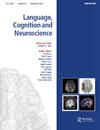语义对象处理是由先验场景上下文调制的
IF 1.8
3区 医学
Q2 AUDIOLOGY & SPEECH-LANGUAGE PATHOLOGY
引用次数: 0
摘要
与场景一致的物体比不一致的物体更容易被识别。此外,不一致对象的语义整合引发了更强的N300/N400脑电成分。然而,上下文信息如何支持对语义对象信息的访问的时间进程和机制尚不清楚。我们使用计算建模和脑电图来测试上下文如何影响语义对象处理。通过表征相似性分析,我们确定了在300毫秒左右的时间内,在一致或不一致场景中的物体之间的脑电图模式分离。通过使用独立赋值属性对对象的语义处理建模,我们证实了一致和不一致对象的语义处理的开始时间是相似的(约150毫秒)。关键的是,在~ 275 ms后,我们发现语义整合持续时间的差异,与一致的对象相比,不一致的对象持续时间更长。这些结果限制了我们对上下文信息如何支持访问语义对象信息的理解。本文章由计算机程序翻译,如有差异,请以英文原文为准。
Semantic object processing is modulated by prior scene context
Objects that are congruent with a scene are recognised more efficiently than objects that are incongruent. Further, semantic integration of incongruent objects elicits a stronger N300/N400 EEG component. Yet, the time course and mechanisms of how contextual information supports access to semantic object information is unclear. We used computational modelling and EEG to test how context influences semantic object processing. Using representational similarity analysis, we established that EEG patterns dissociated between objects in congruent or incongruent scenes from around 300 ms. By modelling the semantic processing of objects using independently normed properties, we confirm that the onset of semantic processing of both congruent and incongruent objects is similar (∼150 ms). Critically, after ∼275 ms, we discover a difference in the duration of semantic integration, lasting longer for incongruent compared to congruent objects. These results constrain our understanding of how contextual information supports access to semantic object information.
求助全文
通过发布文献求助,成功后即可免费获取论文全文。
去求助
来源期刊

Language Cognition and Neuroscience
AUDIOLOGY & SPEECH-LANGUAGE PATHOLOGY-BEHAVIORAL SCIENCES
CiteScore
4.50
自引率
13.00%
发文量
70
期刊介绍:
Language, Cognition and Neuroscience (formerly titled Language and Cognitive Processes) publishes high-quality papers taking an interdisciplinary approach to the study of brain and language, and promotes studies that integrate cognitive theoretical accounts of language and its neural bases. We publish both high quality, theoretically-motivated cognitive behavioural studies of language function, and papers which integrate cognitive theoretical accounts of language with its neurobiological foundations.
The study of language function from a cognitive neuroscience perspective has attracted intensive research interest over the last 20 years, and the development of neuroscience methodologies has significantly broadened the empirical scope of all language research. Both hemodynamic imaging and electrophysiological approaches provide new perspectives on the representation and processing of language, and place important constraints on the development of theoretical accounts of language function and its neurobiological context.
 求助内容:
求助内容: 应助结果提醒方式:
应助结果提醒方式:


